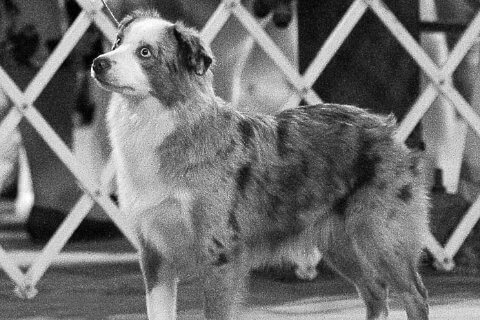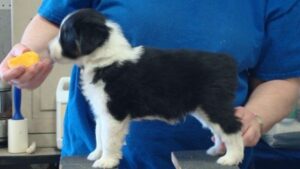
How to Choose & Prepare a Miniature American Shepherd For the Show Ring
From birth to show ring: training and socialization methods for raising confident, well-prepared Miniature American Shepherds.
Home » Meet The Breeds » Miniature American Shepherd
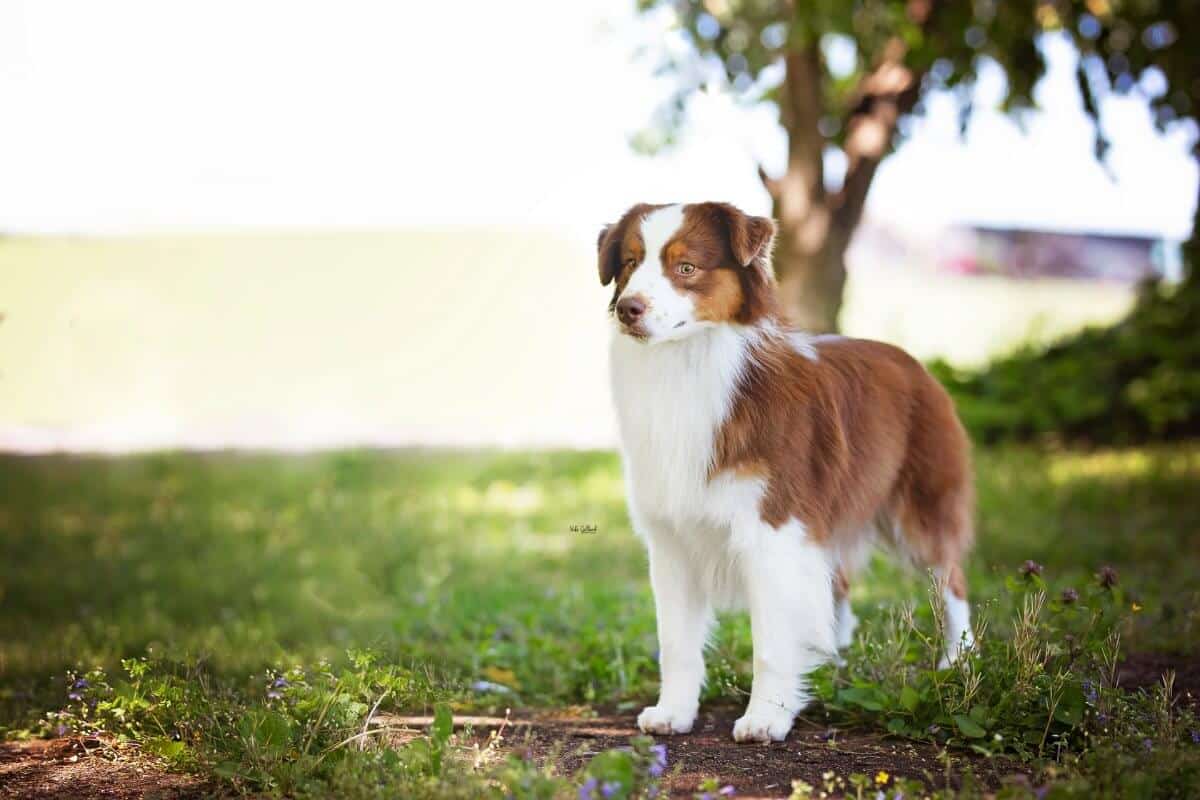
The Miniature American Shepherd, or “MAS” as it is sometimes called, is a diminutive herding dog that combines the intelligent, energetic, and trainable nature of its larger counterpart, the Australian Shepherd, with a smaller, more moderate, frame. Known for its agility, loyalty, and affectionate nature, the breed is both a versatile working dog and a devoted companion. These dogs possess a keen intellect, strong herding instincts, and a profound eagerness to please, making them excellent candidates for various dog sports and activities that demand a lot from a dog. Despite their small stature, they are hearty and robust, displaying a work ethic and vigor that belie their size.
Herding
13 – 18 Inches
20 – 40 Pounds
12 – 13 Years
| Country of Origin | United States |
|---|---|
| Bred For | Sheep & Goat Herding, Guarding, Companionship |
| Known For | Loyalty, Intelligence, Versatility |
| Popularity | High |
| Temperament | Devoted, Intelligent, Persistent |
| Activities | Herding, Running, Hiking, Watchdog, Conformation Shows, Dog Sports |
The Miniature American Shepherd has a rich history that underscores its popularity and versatility as a breed. Originating in the United States, the MAS was developed from Australian Shepherds that were bred to maintain that breed’s herding abilities, intelligence, and high energy levels but in a smaller package.
In the 1960s, enthusiasts sought to create a compact herder that possessed the agility and drive necessary for effective livestock management. This led to the intentional breeding of smaller Australian Shepherds, a breed renowned for its herding prowess and intelligence. The result was the Miniature American Shepherd, a unique breed that encapsulated the desirable traits of its larger counterpart, but in a dog of more manageable size.
The breed’s popularity quickly grew, especially among equestrian enthusiasts who found the MAS to be an excellent companion for horseback riding activities, given its small size and agility. This affiliation with the horsey set helped to bolster the breed’s popularity across the United States.
In terms of official recognition, the Miniature American Shepherd achieved a significant milestone in 2011 when it was recognized by the American Kennel Club (AKC) within the registry’s Foundation Stock Service, a critical step towards full breed recognition. The breed ultimately achieved full recognition in the Herding Group in 2015.
The Miniature American Shepherd ’s attributes have also seen it gain popularity outside of the United States, with recognition and interest growing in various countries. The breed’s intelligence, agility, and affectionate nature have cemented its status as a beloved companion, both in family settings and competitive arenas around the world.
Adult male Miniature American Shepherds range from 14 to 18 inches tall at the shoulders, while females are slightly smaller, standing between 13 and 17 inches.
In terms of weight, Miniature American Shepherds typically weigh between 20 and 40 pounds.
The Miniature American Shepherd is slightly longer than it is tall, with a balanced and athletic build that’s fit for function. These dogs possess moderate bone, neither too heavy nor too fine, which supports both agility and stamina. The overall impression is one of a sturdy, resilient dog that has nimble reflexes and is capable of the quick movements that are essential traits of a herding dog. The substance and proportion of a MAS reflect its heritage and the ability to perform the demanding tasks required to herd a variety of livestock.
Texture: The Miniature American Shepherd sports a double coat that is weather-resistant, insulating, and of medium length. Like the dog itself, the coat is moderate, featuring a somewhat wavy to straight outer layer that stands up to various weather conditions. A frill and mane, and feathering on the backs of the forelegs and breeches of the hindquarters, give this hard-working herder a somewhat stylish appearance. The guard hairs are coupled with a soft and dense undercoat that insulates the dog and adapts it seamlessly to both warm and cold environments. This dual-layered coat equips the breed splendidly for a range of outdoor activities.
| Standard Color | |
|---|---|
| Black | ee |
| Blue Merle | ee |
| Red | ee |
| Red Merle | ee |
A Note About Color: The MAS is a particularly colorful breed, appearing in black or red and blue merle or red merle, with or without tan and/or white markings. No preference is given to color and/or markings, and asymmetrical markings are acceptable. Tan may appear around the eyes and on the muzzle, chest, and under the neck. White markings often appear as a blaze on the head and on the muzzle, neck, chest, belly, and legs. Ticking may be present on the white areas.
| Standard Marking | |
|---|---|
| Tan Points | ee |
| White Markings | ee |
| White Markings, Tan Points | ee |
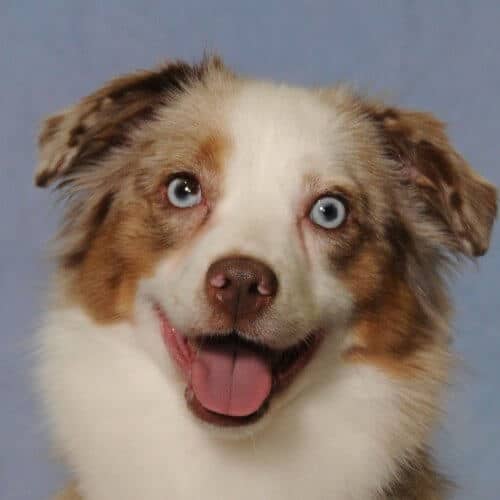
The Miniature American Shepherd’s tail, or lack thereof, is a distinctive breed feature. The tail is set low on the body, following the natural line of the croup, and is straight. MAS can be born with either a natural “bobtail” or a long tail. When the tail is long, it reaches at least down to the hocks in a slight curve.
Some MAS have their long tails docked. The decision to do so is most often considered for dogs that are expected to work livestock, but some jurisdictions around the world prohibit the practice altogether. When docked, the tail should not exceed three inches in length. Naturally long tails are carried either straight or slightly curved, but they should never curl over the dog’s back.
Embracing the Miniature American Shepherd as a companion means welcoming an intelligent, energetic, and affectionate dog into the home. This breed, with its agility and keen senses, is beloved by many who can provide the attentive care and engagement it requires. Prospective owners should be prepared offer an active lifestyle and be ready to invest time into training, exercise, and socialization that will nurture the best qualities in the MAS.
The Miniature American Shepherd is generally a hardy and healthy breed, known for its stamina and resilience. However, as with all breeds and mixed breeds, they are not immune to certain health conditions. Being proactive and informed about the potential health risks is crucial.
Lifespan: The lifespan of a Miniature American Shepherd typically ranges from 12 to 13 years, although with proper care, regular veterinary check-ups, and a balanced diet some individuals can enjoy a longer, healthier life.
The Miniature American Shepherd is a sturdy and agile breed, but like all dogs, individuals can be susceptible to specific health conditions. Here is a list of potential risks that owners should be aware of:
It is crucial for owners to maintain an open relationship with their dog’s breeder and to provide regular veterinary check-ups. These exams can allow for early detection and management of any health issue, contributing to a longer, healthier life for the dog.
The Miniature American Shepherd is renowned for its intelligence, agility, and affectionate nature, making it a delightful companion for active families and individuals alike. However, potential owners should be aware that this breed demands engagement and thrives in an environment where the dogs can exercise both their minds and their bodies.
While the MAS can be a good choice for novice owners, it is important to understand that this breed requires consistent training and socialization from the start. The intelligence of these dogs means they can pick up on commands quickly, but it also means they need mental stimulation to prevent boredom and the development of any undesirable behavior.
In terms of sensitivity, the Miniature American Shepherd has a responsive nature, one that is attuned to its owner’s emotions and to the environment. This sensitivity, while contributing to the breed’s trainability, also means these dogs prefer a stable, consistent living environment.
When it comes to being alone, the MAS values companionship and may not appreciate being left alone for extended periods. Engaging toys and activities, as well as regular interaction with family members, can help to mitigate any potential issues related to brief periods of being separated.
Regarding their interaction with other dogs, Miniature American Shepherds generally get along well with their canine counterparts, particularly when properly introduced and socialized from a young age. Their herding instinct, however, may come into play, and it is not uncommon for these dogs to try and herd other pets or even people.
In terms of the breed’s behavior with young children, the MAS can be a wonderful family pet, although its interaction with very young kids should always be supervised. Teaching children how to appropriately interact with the dog, and training the MAS to be gentle with kids, is crucial for a encouraging a reliable relationship.
While this breed can be reserved around strangers, proper socialization can help to ensure that the Miniature American Shepherd remains friendly and open to new experiences. The breed’s alert nature can make these dogs excellent watchdogs, although they should be taught to distinguish between normal and abnormal behavior to prevent wariness or excessive nervousness.
Providing a balanced and nutritious diet is crucial for the overall health and well-being of a Miniature American Shepherd. This vibrant and active breed necessitates high-quality dog food that aligns with their age, size, and activity level.
When feeding a Miniature American Shepherd puppy, it’s crucial to provide them with a diet specifically formulated for puppies, particularly for medium-sized breeds. Puppies have different nutritional needs compared to adult dogs, and feeding them the right food is imperative for their growth and development. A puppy should be fed three to four times a day as they require a steady supply of energy for their playful and active behavior.
As they mature into adulthood, their feeding regimen should transition to two meals per day. Adult Miniature American Shepherds generally do well on a balanced diet of high-quality, commercially available dog food. However, the exact amount of food they require can vary based on their age, size, and activity level. On average, a Miniature American Shepherd might require between 1 to 1.5 cups of dry dog food per day, but this should be adjusted to maintain their optimal weight and health.
When figuring out the suitable portion sizes and feeding schedule for a Miniature American Shepherd, it is advisable to seek advice from a veterinarian. They can offer valuable recommendations tailored to the unique health condition of the dog, making certain that it receives the necessary nutrients in proper quantities
In addition to their regular meals, it’s important to monitor the amount of treats given, especially during training sessions. Treats are a helpful training aid, but they should only constitute a small portion of the dog’s daily caloric intake.
Lastly, always make sure that fresh water is readily available, providing them with constant hydration, which is crucial for their overall health.
Training a Miniature American Shepherd, known for its intelligence and eagerness to learn, can be a gratifying experience. They typically respond well to training sessions, making them a suitable option for both novice and experienced dog handlers. However, it’s vital to start training and socialization early in their life to foster good behavior and adaptability.
With a high level of intelligence, this breed grasps commands quickly, but they also require mental stimulation to prevent boredom and the potential for unwanted behaviors. Incorporating games and activities that challenge their intellect can be beneficial. Puzzle toys and obedience training are excellent ways to keep their minds engaged.
When it comes to vocalizations, the Miniature American Shepherds have a tendency to bark, especially if they are trying to alert their human companion of something they deem important. Training them to understand when to bark and when to be quiet is crucial, especially if they reside in a community with close neighbors.
Exploring new environments and potentially wandering off can be tempting for a Miniature American Shepherd due to their herding instincts and curiosity. Therefore, training them to have a reliable recall and making sure that they have a secure area to play are vital for their safety.
Predatory behavior is not commonly seen in this breed, but it’s still important to monitor their interactions with smaller pets due to their herding instinct. Positive reinforcement techniques work well in training them to behave appropriately around other animals.
Owning a Miniature American Shepherd comes with the commitment to meet their high exercise needs. This breed brims with energy and enthusiasm, requiring regular physical activity to maintain their health and happiness.
| Energy Level | High |
|---|---|
| Exercise Requirements | 2 Hours/Day (Minimum), Daily Walks, Vigorous Running, Regular Exercise, Playing with Another Dog, Mental Stimulation |
With a considerable energy level, Miniature American Shepherds benefit from a variety of exercises including walks, play sessions, and participation in dog sports. They exhibit an innate agility and intelligence, making them exceptional candidates for activities such as agility training, obedience, and herding events. Engaging them in these activities not only helps in expending their energy but also provides essential mental stimulation.
The intensity of their exercise routine should match their energy levels to keep them in top condition. Integrating playfulness into their exercise regimen can make physical activity more enjoyable for them, promoting a positive experience.
While they have a vivacious spirit, it’s important to strike a balance in their exercise routine, providing them ample opportunities to rest and recover. Adequate exercise contributes to their overall well-being, assisting in the prevention of potential behavioral issues stemming from pent-up energy.
Maintaining the coat of a Miniature American Shepherd requires a consistent grooming routine, though they are relatively easy to groom compared to other breeds. Their double coat, consisting of a weather-resistant outer layer and a soft, dense undercoat, does shed, particularly during seasonal changes. Regular brushing, at least once or twice a week, helps in managing the shedding, keeping their coat in good condition, and promoting healthy skin.
| Coat Type | Straight to Wavy, Medium Length, Weather-Resistant |
|---|---|
| Grooming Requirements | Weekly Brushing, Occasional Bathing, Routine Ear Cleaning, Periodic Nail Trimming, Regular Tooth Brushing |
When it comes to shedding, owners can expect a moderate amount throughout the year, with an increase during seasonal transitions. Implementing a consistent grooming routine during these peak shedding periods can significantly reduce the amount of loose hair in the home and prevent matting in the dog’s coat.
In addition to brushing, their grooming routine should include standard care practices such as regular nail trims, ear cleaning, and dental care. Checking their ears consistently for signs of infection or irritation and brushing their teeth regularly helps in maintaining their overall health.
While the Miniature American Shepherd does not require extensive grooming like some other breeds, dedicating time to their coat care and general hygiene contributes to their well-being and fortifies the bond between the dog and their human companion.
The Miniature American Shepherd is a versatile breed, capable of adapting to various living conditions. However, there are certain aspects to consider to provide them with a comfortable and happy life.
Living in an apartment is possible with this breed, provided they receive sufficient exercise and mental stimulation. They have a compact size, but their high energy levels mean they thrive in environments where they can move freely and play. Providing them with daily walks, playtime, and engagement in activities helps in channeling their energy positively.
When it comes to weather adaptability, the breed’s double coat offers protection against different weather conditions. They can tolerate both cold and warm climates due to their insulating undercoat and weather-resistant outer coat. Despite this, it’s important to provide them with a cool, shaded place during hot weather and a warm, dry shelter in colder conditions to ensure their comfort.
Overall, with proper exercise, mental stimulation, and attention to their comfort in varying weather conditions, the Miniature American Shepherd can be a joyful and content companion in diverse living situations.
The arrival of a litter of Miniature American Shepherd puppies is a delightful experience, one that is filled with joy and anticipation. These pups are known for their intelligence, agility, and playful nature, making them wonderful companions for active families and individuals. However, bringing a puppy into a new home requires preparation and understanding of the breed’s specific needs to ensure a smooth transition and healthy development.
From the moment a Miniature American Shepherd puppy enters the home, providing proper care becomes paramount. The little pup is already energetic and intelligent, requiring early socialization to develop appropriate behavior. Introducing the puppy to a variety of people, places, and situations helps in positively shaping its temperament and behavior.
Nutrition plays a critical role in the puppy’s development, and feeding a high-quality puppy food designed for medium-sized breeds ensures it receives the right balance of nutrients. it is important to pay attention to the pup’s growth and adjust the amount of food given accordingly while maintaining a regular feeding schedule.
Training should commence early, utilizing positive reinforcement techniques to encourage good behavior. The Miniature American Shepherd puppy is eager to learn and responds well to consistent and patient training. Housebreaking and basic obedience training are essential components of a pup’s early education.
Regular veterinary check-ups are vital to monitor the puppy’s growth and to address any potential health issues promptly. These exams will ensure the pup receives all the necessary vaccinations and preventative care that is needed to safeguard its health.
Providing the puppy with a safe and loving environment, combined with proper nutrition, training, and wellness care, sets the foundation for supporting its growth and its health as an adult.
The Miniature American Shepherd is an agile, intelligent, and energetic breed that excels in various activities and dog sports. The breed’s enthusiasm and eagerness to participate makes it an outstanding contender in different competitive and recreational arenas. These include:
By participating in these activities, Miniature American Shepherds not only engage their bodies but also stimulate their minds, ensuring a well-rounded and happy life. These events also strengthen the bond between the dog and their handler, fostering a deep connection and mutual respect.
The Miniature American Shepherd is recognized by the world’s leading registries and kennel organizations, which categorize the breed into a specific Group based on its unique characteristics. This breed is recognized worldwide under the following Group designations:
| Organization | Group Designation |
|---|---|
| AKC (American Kennel Club) | Herding |
| UKC (United Kennel Club) | Herding Dog |
| CKC (Canadian Kennel Club) | Herding |
| ANKC (Australian National Kennel Council) | Not Recognized |
| RKC (The Royal Kennel Club) | Not Recognized |
| FCI (Fédération Cynologique Internationale) | Group 1: Sheepdogs and Cattledogs; Section 1: Sheepdogs |
The ideal Miniature American Shepherd is described by a Breed Standard that is approved by each of the world’s leading registries and kennel organizations. The Breed Standards for this breed may be found in the following links:
| Organization | Breed Standard |
|---|---|
| American Kennel Club | AKC Miniature American Shepherd Breed Standard |
| United Kennel Club | UKC Miniature American Shepherd Breed Standard |
| Canadian Kennel Club | CKC Miniature American Shepherd Breed Standard |
| Australian National Kennel Council | Not Recognized |
| The Royal Kennel Club | Not Recognized |
| Fédération Cynologique Internationale | FCI Miniature American Shepherd Breed Standard |
The Miniature American Shepherd enjoys support and representation through various breed clubs across the world, which play a crucial role in promoting the breed, providing education, and supporting responsible breeding practices.
In the United States, the Miniature American Shepherd Club of the USA (MASCUSA) stands out as a prominent organization dedicated to the breed. MASCUSA provides a platform for enthusiasts, breeders, and owners to connect, share knowledge, and participate in breed-specific activities. The club also emphasizes the importance of maintaining the breed standard and encourages responsible breeding practices to ensure the health and well-being of Miniature American Shepherds.
In Canada, the Miniature American Shepherds of Canada (MASCAN) is actively involved in promoting the breed, organizing events, and fostering a community of enthusiasts and breeders who are dedicated to the well-being of Miniature American Shepherds.
These clubs and organizations play a vital role in sustaining the breed’s legacy, promoting responsible ownership, and providing valuable resources for anyone interested in Miniature American Shepherds. They offer a sense of community for those who are passionate about the breed, ensuring that Miniature American Shepherds continue to thrive and receive the recognition they deserve.
The Miniature American Shepherd, like all breeds, occasionally finds itself in need of rescue and adoption. Several organizations and rescue groups work tirelessly to provide assistance, ensuring these dogs find loving and permanent homes.
In the United States, the national club for the breed, the Miniature American Shepherd Club of the USA (MASCUSA), plays a significant role in the rescue and rehoming of Miniature American Shepherds. Through their dedicated rescue network, MASCUSA helps to provide rehabilitation, foster care, and adoption services, ensuring that these intelligent and active dogs find their way into suitable and loving homes. The club’s involvement in rescue efforts underscores their commitment to the well-being and responsible ownership of Miniature American Shepherds.
It’s also worth noting that local shelters and broader rescue organizations might have Miniature American Shepherds available for adoption. Adopting a dog, regardless of its origin, provides a second chance at a loving home and a fulfilled life.
Miniature American Shepherds can have a high prey drive due to their herding instincts. This can sometimes lead to chasing smaller animals, including cats. However, if an MAS is raised with cats from a young age or is properly introduced in a controlled manner, it can learn to coexist peacefully. Consistent training and supervision are key to ensuring a harmonious relationship between a Miniature American Shepherd and a household cat.
The Miniature American Shepherd is not considered hypoallergenic. These dogs have a double coat that sheds throughout the year, and they experience a heavier shedding during the spring and fall seasons. Individuals with allergies to pet dander can experience reactions when around Miniature American Shepherds, so it is important to spend time with the breed before bringing one home.
Yes, Miniature American Shepherds shed. They have a double coat that requires regular grooming to manage shedding and to keep the coat in good condition. While they do shed year-round, an increase in shedding is more noticeable as the seasons change, particularly during autumn and springtime.
Miniature American Shepherds are known to be vocal and may bark to alert their owners to something unusual, to get attention, or when they are particularly excited. Proper training and socialization from a young age can help to manage excessive barking, and providing enough mental stimulation and physical exercise is also crucial to prevent the kind of boredom that can lead to barking.
Miniature American Shepherds can make great family pets for active households. They are intelligent and trainable, and they have a lot of energy to burn. However, due to their herding instincts they may try to herd small children. So, it is important to supervise all interactions and teach both the dog and the kids how to interact safely and respectfully.
Miniature American Shepherds are excellent hiking companions due to their high energy levels, agility, and endurance. They enjoy being outdoors and are well-suited for long hikes and outdoor adventures. Ensuring they are well-trained and have a good recall is important when hiking, however, especially if they are permitted to be off-leash.
Miniature American Shepherds are often born with a long tail, but it is a common practice to dock this natural tail. The decision to dock a puppy’s tail is typically made by the breeder when the puppy is a few days old. However, some MAS do retain their full tails, which doesn’t affect the dog’s ability to function as a companion.
In terms of grooming, Miniature American Shepherds are moderately high maintenance due to their double coat, which requires regular brushing to prevent matting and to manage shedding. In terms of exercise and mental stimulation, they are high maintenance and thrive in active environments where they can engage in physical activities and brain games. Making sure they are well-exercised and mentally stimulated is crucial for their well-being.
Miniature American Shepherds are social dogs that thrive on interaction and engagement. Leaving them alone for extended periods can lead to boredom and potentially destructive behaviors. If it is necessary to leave them alone, providing toys and interactive games, as well as ensuring they have been adequately exercised beforehand, can help. However, these active dogs are best suited to households where they are not regularly left alone for long periods of time.

From birth to show ring: training and socialization methods for raising confident, well-prepared Miniature American Shepherds.
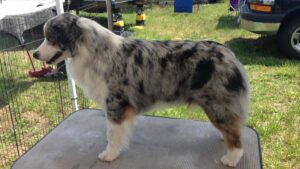
Discover how to turn your Miniature American Shepherd into a confident show dog with proper exposure, training, and rewarding experiences.
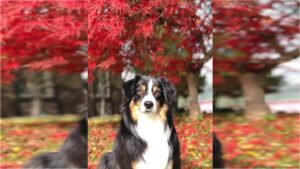
The Miniature American Shepherd requires generations of careful breeding to maintain proper proportions, soundness, and type.
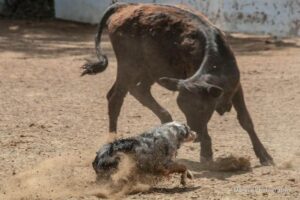
Larry, and I get the reaction of “You Do What?” from people who ask us what we are doing in our retirement. “We do competitive herding.
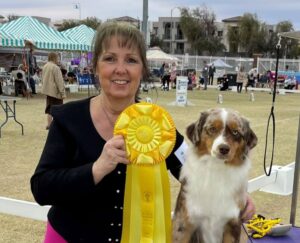
Interview with Herding Group Breeder Allyson Senek – I live on the back side of the Colorado National Monument in Glade Park, Colorado.
The best way to ensure a long and happy relationship with a purebred dog is to purchase one from a responsible breeder. Not sure where to begin?
Contact the National Parent Club’s Breeder Referral Program, which is listed on the AKC Breeder Referral Contacts page.
